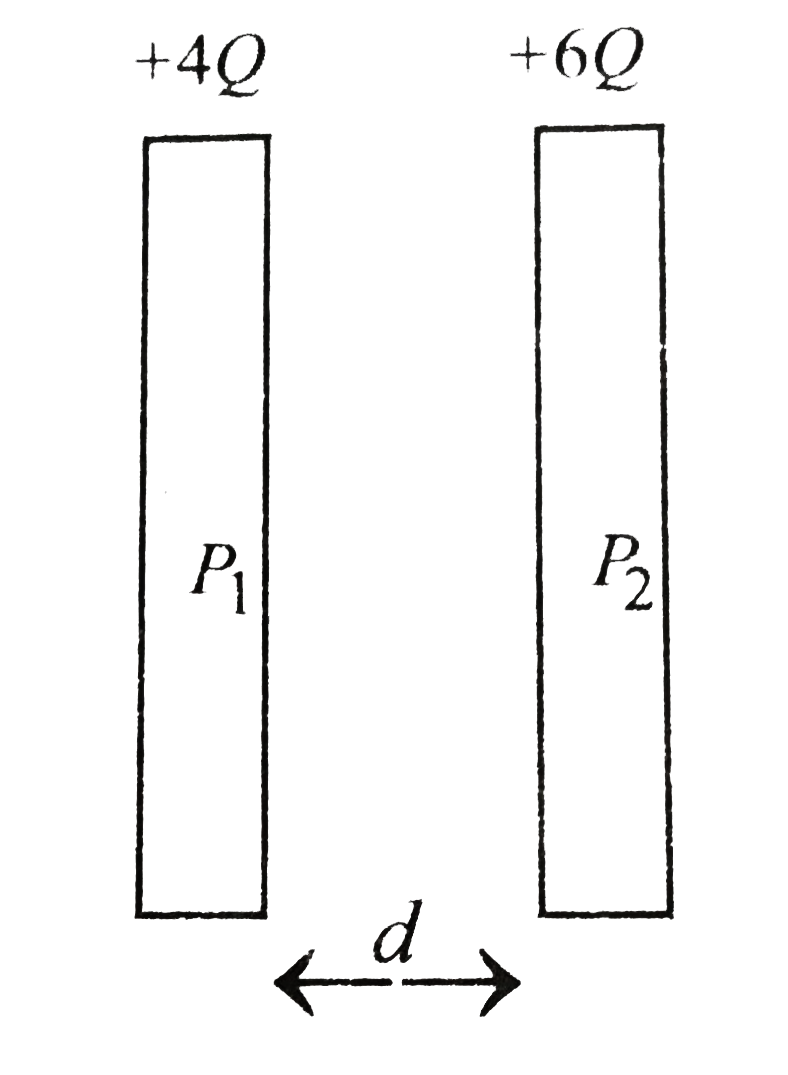Two identical conducting balls A and B have charges- Q and + 3Q respectively. They are brought in contact with each other and then separated by a distance d part. Find the nature of the Coulomb force between them.
To solve the problem step by step, we will analyze the situation involving the two identical conducting balls A and B, their initial charges, the process of contact, and the resulting forces.
1. Identify Initial Charges:
- Ball A has a charge of −Q.
- Ball B has a charge of +3Q.
2. Calculate the Total Charge When in Contact:
- When the two balls are brought into contact, the total charge Qtotal is the sum of the charges on both balls:
Qtotal=−Q+3Q=2Q
3. Distribute the Charge Equally:
- Since the balls are identical conductors, the total charge will distribute equally between them when they are in contact. Therefore, each ball will have a charge of:
QA=QB=Qtotal2=2Q2=Q
4. Determine the Nature of the Charges After Contact:
- After contact, both balls A and B have a charge of +Q. Since both charges are positive, they are of the same nature.
5. Apply Coulomb's Law:
- The Coulomb force F between two charges is given by:
F=k|Q1Q2|r2
- Here, Q1=Q and Q2=Q, and the distance r between them after separation is d. Thus, the force becomes:
F=kQ⋅Qd2=kQ2d2
6. Determine the Nature of the Force:
- Since both charges are positive, they will repel each other. Therefore, the nature of the Coulomb force between them is repulsive.
Final Answer:
The nature of the Coulomb force between the two balls after they are separated is repulsive.
- Ball A has a charge of −Q.
- Ball B has a charge of +3Q.
- When the two balls are brought into contact, the total charge Qtotal is the sum of the charges on both balls:
Qtotal=−Q+3Q=2Q
- Since the balls are identical conductors, the total charge will distribute equally between them when they are in contact. Therefore, each ball will have a charge of:
QA=QB=Qtotal2=2Q2=Q
- After contact, both balls A and B have a charge of +Q. Since both charges are positive, they are of the same nature.
- The Coulomb force F between two charges is given by:
F=k|Q1Q2|r2
- Here, Q1=Q and Q2=Q, and the distance r between them after separation is d. Thus, the force becomes:
F=kQ⋅Qd2=kQ2d2
- Since both charges are positive, they will repel each other. Therefore, the nature of the Coulomb force between them is repulsive.
The nature of the Coulomb force between the two balls after they are separated is repulsive.
Topper's Solved these Questions
- BOOK - XII BOARD PREVIOUS YEAR PAPER ENGLISHCHAPTER - XII BOARDSEXERCISE - SECTION - B7videos
XII BOARDS
- BOOK - XII BOARD PREVIOUS YEAR PAPER ENGLISHCHAPTER - XII BOARDSEXERCISE - SECTION - C10videos
XII BOARDS
- BOOK - XII BOARD PREVIOUS YEAR PAPER ENGLISHCHAPTER - SAMPLE PAPER 2019EXERCISE - SECTION D6videos
SAMPLE PAPER 2019
Similar Questions
Two concentric conducting shells of radii R and 2R are having charges Q and -2Q respectively.In a region r
View SolutionTwo identical conductiing balls A and B have positive charges q12andq2 respectively. But q1≠q2. The balls are brought together so that they touchj each each other and then kept in their original positions .The force between them is
View SolutionTwo identical small conducting balls have positive charges q1 and q2 respectively. The force between the balls when they are placed at a separation is F. The balls are brought together so that they touch and then put back in their original positions. Prove that the force between the balls now, cannot be less than F.
View SolutionTwo small identical conducting balls A and B of charges +10μC and +30μC respectively, are kept at a separation of 50 cm. these balls have been connected by a wire for a short time
The final charge on each of the balls A and B and force of interaction will beView SolutionHow does the distance of separation between two bodies affect the magnitude of the non-contact force between them ?
View SolutionTwo unlike charges of magnitude q are separated by a distance 2d. The potential at a point midway between them is
View SolutionTwo identical conducting very large plates P1andP2 having charges +4Qand+6Q are placed very closed to each other at separation d. The plate area of either face of the plate is A. The potential difference between plates P1andP2 is
 View Solution
View SolutionTwo identical metal plates are given poistive charges Q1 and Q2 (<Q1) respectively. If they are now brought close together to form a parallel plate capacitor with capacitance C, the potencial difference between them is
View SolutionTwo identical metals balls with charges +2Q and −Q are separated by some distance and exert a force F on each other . They are joined by a conducting wire , which is then removed. The force between them will now be
View SolutionTwo identical small conducting spheres having unequal positive charges q1 and q2 are separated by a distance r. If they are now made to touch each other and then separated again to the same distance, the electrostatic force between them in this case will be
View Solution

